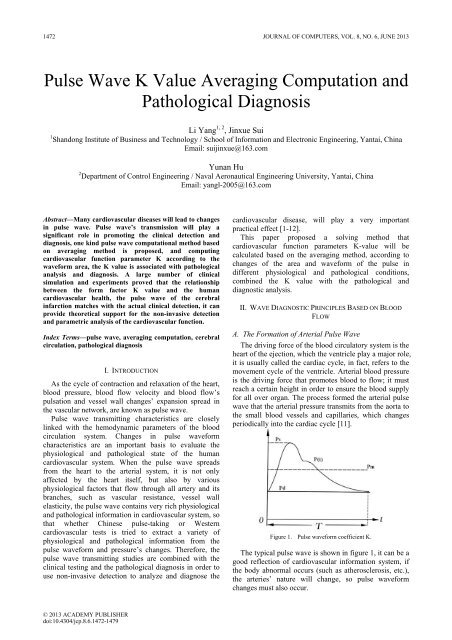Download Full Issue in PDF - Academy Publisher
Download Full Issue in PDF - Academy Publisher
Download Full Issue in PDF - Academy Publisher
You also want an ePaper? Increase the reach of your titles
YUMPU automatically turns print PDFs into web optimized ePapers that Google loves.
1472 JOURNAL OF COMPUTERS, VOL. 8, NO. 6, JUNE 2013<br />
Pulse Wave K Value Averag<strong>in</strong>g Computation and<br />
Pathological Diagnosis<br />
Li Yang 1, 2 , J<strong>in</strong>xue Sui<br />
1 Shandong Institute of Bus<strong>in</strong>ess and Technology / School of Information and Electronic Eng<strong>in</strong>eer<strong>in</strong>g, Yantai, Ch<strong>in</strong>a<br />
Email: suij<strong>in</strong>xue@163.com<br />
Yunan Hu<br />
2 Department of Control Eng<strong>in</strong>eer<strong>in</strong>g / Naval Aeronautical Eng<strong>in</strong>eer<strong>in</strong>g University, Yantai, Ch<strong>in</strong>a<br />
Email: yangl-2005@163.com<br />
Abstract—Many cardiovascular diseases will lead to changes<br />
<strong>in</strong> pulse wave. Pulse wave’s transmission will play a<br />
significant role <strong>in</strong> promot<strong>in</strong>g the cl<strong>in</strong>ical detection and<br />
diagnosis, one k<strong>in</strong>d pulse wave computational method based<br />
on averag<strong>in</strong>g method is proposed, and comput<strong>in</strong>g<br />
cardiovascular function parameter K accord<strong>in</strong>g to the<br />
waveform area, the K value is associated with pathological<br />
analysis and diagnosis. A large number of cl<strong>in</strong>ical<br />
simulation and experiments proved that the relationship<br />
between the form factor K value and the human<br />
cardiovascular health, the pulse wave of the cerebral<br />
<strong>in</strong>farction matches with the actual cl<strong>in</strong>ical detection, it can<br />
provide theoretical support for the non-<strong>in</strong>vasive detection<br />
and parametric analysis of the cardiovascular function.<br />
Index Terms—pulse wave, averag<strong>in</strong>g computation, cerebral<br />
circulation, pathological diagnosis<br />
I. INTRODUCTION<br />
As the cycle of contraction and relaxation of the heart,<br />
blood pressure, blood flow velocity and blood flow’s<br />
pulsation and vessel wall changes’ expansion spread <strong>in</strong><br />
the vascular network, are known as pulse wave.<br />
Pulse wave transmitt<strong>in</strong>g characteristics are closely<br />
l<strong>in</strong>ked with the hemodynamic parameters of the blood<br />
circulation system. Changes <strong>in</strong> pulse waveform<br />
characteristics are an important basis to evaluate the<br />
physiological and pathological state of the human<br />
cardiovascular system. When the pulse wave spreads<br />
from the heart to the arterial system, it is not only<br />
affected by the heart itself, but also by various<br />
physiological factors that flow through all artery and its<br />
branches, such as vascular resistance, vessel wall<br />
elasticity, the pulse wave conta<strong>in</strong>s very rich physiological<br />
and pathological <strong>in</strong>formation <strong>in</strong> cardiovascular system, so<br />
that whether Ch<strong>in</strong>ese pulse-tak<strong>in</strong>g or Western<br />
cardiovascular tests is tried to extract a variety of<br />
physiological and pathological <strong>in</strong>formation from the<br />
pulse waveform and pressure’s changes. Therefore, the<br />
pulse wave transmitt<strong>in</strong>g studies are comb<strong>in</strong>ed with the<br />
cl<strong>in</strong>ical test<strong>in</strong>g and the pathological diagnosis <strong>in</strong> order to<br />
use non-<strong>in</strong>vasive detection to analyze and diagnose the<br />
cardiovascular disease, will play a very important<br />
practical effect [1-12].<br />
This paper proposed a solv<strong>in</strong>g method that<br />
cardiovascular function parameters K-value will be<br />
calculated based on the averag<strong>in</strong>g method, accord<strong>in</strong>g to<br />
changes of the area and waveform of the pulse <strong>in</strong><br />
different physiological and pathological conditions,<br />
comb<strong>in</strong>ed the K value with the pathological and<br />
diagnostic analysis.<br />
II. WAVE DIAGNOSTIC PRINCIPLES BASED ON BLOOD<br />
FLOW<br />
A. The Formation of Arterial Pulse Wave<br />
The driv<strong>in</strong>g force of the blood circulatory system is the<br />
heart of the ejection, which the ventricle play a major role,<br />
it is usually called the cardiac cycle, <strong>in</strong> fact, refers to the<br />
movement cycle of the ventricle. Arterial blood pressure<br />
is the driv<strong>in</strong>g force that promotes blood to flow; it must<br />
reach a certa<strong>in</strong> height <strong>in</strong> order to ensure the blood supply<br />
for all over organ. The process formed the arterial pulse<br />
wave that the arterial pressure transmits from the aorta to<br />
the small blood vessels and capillaries, which changes<br />
periodically <strong>in</strong>to the cardiac cycle [11].<br />
Figure 1. Pulse waveform coefficient K.<br />
The typical pulse wave is shown <strong>in</strong> figure 1, it can be a<br />
good reflection of cardiovascular <strong>in</strong>formation system, if<br />
the body abnormal occurs (such as atherosclerosis, etc.),<br />
the arteries’ nature will change, so pulse waveform<br />
changes must also occur.<br />
© 2013 ACADEMY PUBLISHER<br />
doi:10.4304/jcp.8.6.1472-1479
















